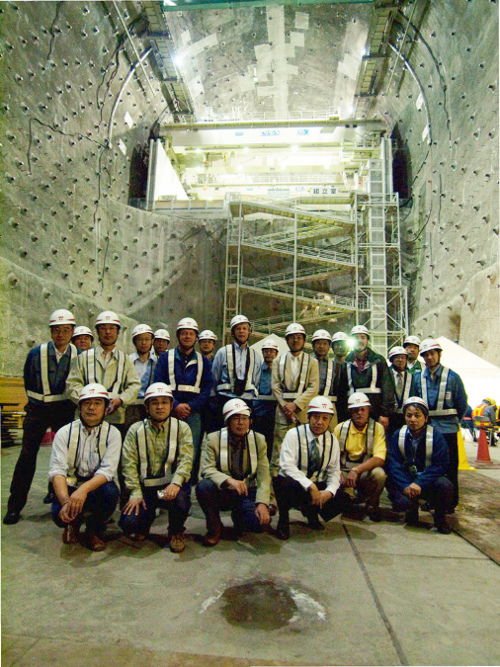Director's Corner
30 September 2010
The ILC in a mountainous region – A report on Japanese efforts to develop possible sites
Today's issue features a Director's Corner from Marc Ross, Project Manager for the Global Design Effort.
Roughly six years ago the International Committee for Future Accelerators accepted the recommendation to adopt 'cold', superconducting radiofrequency (RF) technology for the linear collider’s main linac. The recommendation came shortly after an extensive review of the designs of the ILC’s forerunner projects, TESLA, NLC and JLC. The main linac technology planned for the ILC, now under development in each region, is quite similar to that of the TESLA design.
Of course, the TESLA design included much more than a plan to deploy cold RF technology. In particular, the TESLA Technical Design Report included a conventional facilities design and a plan for a site in Germany located along a line stretching towards the northwest from DESY. In contrast to our adoption of cold RF technology, the conventional facilities design for TESLA was not adopted; a quite different design for the ILC has emerged and this has broad implications for several subsystems. The TESLA underground construction scheme was optimised to best suit a site in sandy, flat, water-logged ground with much of the underground construction below the water table, requiring appropriate design techniques.
 Review committee members at the Kannagawa hydroelectric power plant during the CFS review meeting held in June. Image : Nobuko Kobayashi/ courtesy of Tokyo Electric Power Company Review committee members at the Kannagawa hydroelectric power plant during the CFS review meeting held in June. Image : Nobuko Kobayashi/ courtesy of Tokyo Electric Power Company |
In the Technical Design Phase, we now face a new challenge, namely how to make sure the ILC design is suitable for a variety of possible sites, including those similar to the DESY site and those quite unlike it. This includes, for example, sites in mountainous regions. If the ILC is to be constructed in Japan, it will almost certainly be situated in a mountainous region. After all, about 70 percent of Japan is mountainous and remains relatively uninhabited.
There is an encouraging possibility that Japan will bid to host the ILC. Earlier this month, at the autumn meeting of the Physical Society of Japan held at the Kyushu Institute of Technology, representatives of the Japanese ILC community announced two potential ILC sites. The two locations are at opposite ends of the Japanese archipelago, one in the Seburi-area, 30 kilometers south of the city of Fukuoka in northwestern Kyushu island, and the other in the Kitakami-area, 100 kilometers north of the city of Sendai in northern Honshu island. In both cases, local prefectural governments and universities have partnered to study these potential sites. Studies include exploratory bore-hole drilling and survey.
Given the general aspects of a typical mountain region site, it is up to us, the Global Design Effort (GDE) and our partners, to interpret criteria we developed for the Reference Design such that all involved can readily conclude whether such a site would work and would be cost-effective. This means, for example, developing a better understanding of how the high-power microwave systems and basic utilities such as water, power and cryogenics, could be built differently from the Reference Design Report in order to suit such a place. In a typical mountain site, the surface of the land is undeveloped and inaccessible and the tunnel could be quite deep. Also the geology could be quite complicated, and might consist of fractured, water-bearing rock.
Because Japan has both mountainous geology and a very highly developed national infrastructure, including an extensive network of tunnels, there is a great deal of expertise available to consider how the ILC could be built under these conditions.
Fortunately for the GDE, an alliance of accelerator technology, industry, government and academia was established that has allowed good communication between these groups. ILC NewsLine reported the formation of this unique forum, which has become known as the Advanced Accelerator Association Promoting Science and Technology (AAA), in June 2008. Also, as luck would have it, initial consideration of mountainous region sites comes at the same time as the publication, also in Japan, of a general study of the single-tunnel design in a mountainous region1. The study was published by the AAA in March 2010. It was the focus of a review last June by an international panel chaired by Vic Kuchler of Fermilab.
Much of the review makes fascinating reading. After all, tunneling underneath mountain ranges can sometimes be difficult. The review committee was very impressed by the study and their report was quite positive. Following the meeting, the review team got chance to see first-hand large-scale underground construction in Japan at the Tokyo Electric Power Company's Kannagawa pumped storage plant.
Initial consideration of mountain-region ILC sites comes at the same time as the GDE initiative to reduce the project's conventional construction estimated cost through a 'Baseline Assessment' process. One of the most important changes proposed to the Reference Design baseline is the elimination of the main linac support tunnel. This reduces the total ILC fully-finished tunnel length by about 40%, and represents a significant reduction in cost and construction risk. We expect the change control process for the new baseline to be completed early next year. With a new baseline in hand, and with guidance from the groups who produced the AAA report, we will be able to provide clear criteria to the Japanese site development teams and can look forward to a well-understood, cost-effective design for the Technical Design Report.
-- Marc Ross
